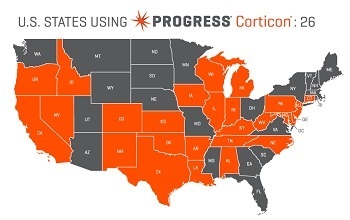K
Kevin Foster
Guest
US States are taking advantage of this government exception, which grants federal funding for upgrading benefit systems with business rules engines and other tech. Progress Corticon is eligible and can dramatically simplify your operations, saving time and money.
The A-87 Cost Allocation Exception is an important consideration for any state trying to modernize their benefits eligibility or administration systems. Released by the Centers for Medicare and Medicaid Services (CMS), Administration for Children and Families (ACF) and USDA Food and Nutrition Service (FNS), it allows states to receive federal reimbursement of up to 90% for upgrading certain applications with Commercial-Off-the-Shelf (COTS) technology—like a business rules engine.
Modernizing legacy systems is among the top CIO priorities for 2016, and a key reason is that agencies across the country are tasked with simplifying benefit determination and administration. In fact, as part of the Affordable Care Act (ACA), states are required to implement business rules to determine eligibility for programs like the Children’s Health Insurance Program (CHIP) based on a single standard. These changes will result in a better user experience, lower costs and greater overall efficiency.
How Progress Corticon Can Help
 Progress Corticon is already deeply familiar with this space, serving as the business rules engine of choice in 26 states. Corticon separates business logic from code, allowing IT, subject matter experts and business analysts to create or modify rules without having to enter into lengthy development cycles when a policy or piece of legislation takes effect. It also compiles into an executable that’s exposed as standards-based services which can be shared across organizations. These features help cut development costs and reduce the time it takes for both employees and citizens to get the information they need.
Progress Corticon is already deeply familiar with this space, serving as the business rules engine of choice in 26 states. Corticon separates business logic from code, allowing IT, subject matter experts and business analysts to create or modify rules without having to enter into lengthy development cycles when a policy or piece of legislation takes effect. It also compiles into an executable that’s exposed as standards-based services which can be shared across organizations. These features help cut development costs and reduce the time it takes for both employees and citizens to get the information they need.
For example, with Corticon, states can:
While states like Indiana have implemented Corticon for Medicaid/Medicare needs, other states across the country have used Corticon for a variety of other systems. The Pennsylvania Department of Human Services (DHS) has been using Corticon to reduce manual processing by case workers and comply with legislation requiring transparency and traceability. They hope to soon use Corticon to enable real-time eligibility decision making, so benefit applicants can fill out a common form online and get an immediate response on eligibility.
As Jim Weaver, CIO of Pennsylvania DHS put it, “Having a single rule service across three systems significantly decreased our effort and our risk when needing to respond quickly to changing operating environments.”
From pensions to health and human services to the Department of Motor Vehicles (DMV), states are putting Corticon to work to cut costs and boost efficiency. The A-87 Cost Allocation Exception is a powerful way that states can modernize these systems at little cost, and an opportunity not to be missed. To learn more about the A-87 Exception and Corticon, download our brief for additional information.
Continue reading...
The A-87 Cost Allocation Exception is an important consideration for any state trying to modernize their benefits eligibility or administration systems. Released by the Centers for Medicare and Medicaid Services (CMS), Administration for Children and Families (ACF) and USDA Food and Nutrition Service (FNS), it allows states to receive federal reimbursement of up to 90% for upgrading certain applications with Commercial-Off-the-Shelf (COTS) technology—like a business rules engine.
Modernizing legacy systems is among the top CIO priorities for 2016, and a key reason is that agencies across the country are tasked with simplifying benefit determination and administration. In fact, as part of the Affordable Care Act (ACA), states are required to implement business rules to determine eligibility for programs like the Children’s Health Insurance Program (CHIP) based on a single standard. These changes will result in a better user experience, lower costs and greater overall efficiency.
How Progress Corticon Can Help
For example, with Corticon, states can:
- Leverage an intuitive interface consisting of business terms to construct rules with drag-and-drop actions
- Create audit trails so users can see rationales for why an applicant was denied or approved
- Improve rules integrity with built-in testing that finds and corrects incomplete, circular or conflicting logic
While states like Indiana have implemented Corticon for Medicaid/Medicare needs, other states across the country have used Corticon for a variety of other systems. The Pennsylvania Department of Human Services (DHS) has been using Corticon to reduce manual processing by case workers and comply with legislation requiring transparency and traceability. They hope to soon use Corticon to enable real-time eligibility decision making, so benefit applicants can fill out a common form online and get an immediate response on eligibility.
As Jim Weaver, CIO of Pennsylvania DHS put it, “Having a single rule service across three systems significantly decreased our effort and our risk when needing to respond quickly to changing operating environments.”
From pensions to health and human services to the Department of Motor Vehicles (DMV), states are putting Corticon to work to cut costs and boost efficiency. The A-87 Cost Allocation Exception is a powerful way that states can modernize these systems at little cost, and an opportunity not to be missed. To learn more about the A-87 Exception and Corticon, download our brief for additional information.
Continue reading...
